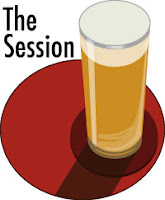Time was, a new Irish beer review was a special effort I put in for St Patrick's Day. These days it's hard to keep up. So here's a round-up of my last few weeks of Irish beer exploring, for the day that's in it.

Meath newcomers Brú quietly released their first IPA last month, called
Rí. Well, it seemed quiet to me: first I saw of it was when it became the début cask beer served from 57 The Headline's new beer engine. It's 5.5% ABV and, thanks to the chilly weather, arrived in my glass beautifully cool. All the right notes are there for a refreshing English-style pale ale: the juicy peach and mandarin without any of the harsher bitterness of the less-genteel IPA-brewing nations. But it's no lightweight, the alcohol content lending it a decent heft. Sip or slurp: your choice. I will say I don't think I got the best of it as the barrel was rushed from brewery to bar on the day so there was a bit of a yeasty, bready burr to it. I noticed the bottled version in the shops lately and would be hoping for a cleaner experience from that. If it can retain the hop complexity of the cask edition it will be a real treat.

Continuing the hop theme,
Franciscan Well Double IPA was a nice surprise when it showed up on tap far from home in Against the Grain. It's a perfectly clear glassful, somewhere between dark orange and pale amber and smells worryingly of toffee more than hops. It's better on tasting, however: pithy, in an old world IPA sort of way. Do I detect the orangey overtones of Styrians, perhaps? Either way I get a distinct echo back to former Franciscan Well classic Alpha Dawg. The crystal malt sweetness becomes more apparent as it warms rounding it off rather nicely. Like Rí it's a well-mannered and approachable hop-forward beer.

The award for having fun with hops goes to Carlow Brewing and their new, ambitious,
O'Hara's Amber Adventure, making its first appearance the week before last as part of a tap-takeover at Farrington's. The plan is a rolling programme of amber ales under the same name, representing a world tour of hop growing regions. We start the quest in New Zealand, the first iteration being a showcase for Pacific Gem and Motueka. An effort has been made at keeping things light and sessionable, so it's only 4.1% ABV and rather pale for the style. But it's far from insipid: the drinking experience is bookended by a big bitter hit at the start and a lingering acidity at the finish. The wonderful hop complexity forms the meat in this hop sandwich: all funky, weedy, resinous dank which is lightened, though not balanced, by mild candy caramel malt. As the colour previously suggested, the malt element is very much understated compared to other amber ales, and while it's good that the hops are pushed to the front, it does mean the end result is a little on the watery side. That said, no other Irish beer offers so much hoppy impact in such a sessionable package, and that makes it a very welcome addition.

Moving on from the hops... Wait, no, that's not how we roll in Ireland these days. Sticking with hops to the very last, a new seasonal from JW Sweetman:
Intergalactic, a 6.8% ABV amber ale. My apologies for the utterly abysmal photo which makes it look like an opaque soupy mess, it's really quite see-through, though is a dark amber colour. One sniff delivers a blast of satsuma zest, in case it wasn't clear enough from the name that Aussie hop Galaxy is in the house. Tasting gives you a rapid flash of orange segment quickly followed by a sterner bitterness. There's a similar resinousness to that found in the house Pale Ale. The malt sits on the sidelines providing a modest amount of balance -- no toffee or caramel interfering here. Overall, an interesting side-step from the Pale Ale, but I was still glad to get back to a proper pint of the latter afterwards.

And never to be outdone when Irish micros are throwing hops around, Galway Bay Brewery have another one from their pilot series which has been around a while but I only just caught up with it last weekend. It's billed as a
Cascadian Dark Ale, 6.8% ABV and served exclusively on cask. The aroma from the opaque dark brown beer is an innocent and inviting sherbet citrus smell, but its true colours are revealed on tasting as a much more harsh, rather waxy, bitterness. The dark malts play good cop to this, adding a cakey sweetness and a comforting creamy texture. Complex and thought-provoking: just what you want from a one-off small-batch brew.
So that's what's going on here. Meanwhile I'm off to Italy this morning, to spread the good news from Ireland to the Romans, like St Patrick in reverse.























